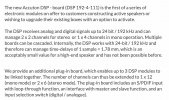MonitorsNZ
Member
- Joined
- Apr 20, 2024
- Messages
- 5
- Likes
- 0
Afternoon All
I've been working away at building a pair of Active Studio monitors.
After about 2 1/2 years of waiting for DSP's and delays on Class D amplifiers, they're making noise.
I'm currently running from an analogue signal from the PC to analogue XLR inputs on each monitor.
But the DSP's in each monitor can take digital AES inputs (via XLR).
I thought there would be a simple way to get from USB on a PC to separate L&R AES XLR connections.
This is my second weekend googling like mad and bothering my local music store without success.
If it had an input for a mic, so I can sort the frequency response with the digital x-overs, this would be ideal.
I'm hoping there's something under $500 that will achieve this.
(but I might be dreaming)....
Cheers...
Ben
I've been working away at building a pair of Active Studio monitors.
After about 2 1/2 years of waiting for DSP's and delays on Class D amplifiers, they're making noise.
I'm currently running from an analogue signal from the PC to analogue XLR inputs on each monitor.
But the DSP's in each monitor can take digital AES inputs (via XLR).
I thought there would be a simple way to get from USB on a PC to separate L&R AES XLR connections.
This is my second weekend googling like mad and bothering my local music store without success.
If it had an input for a mic, so I can sort the frequency response with the digital x-overs, this would be ideal.
I'm hoping there's something under $500 that will achieve this.
(but I might be dreaming)....
Cheers...
Ben



